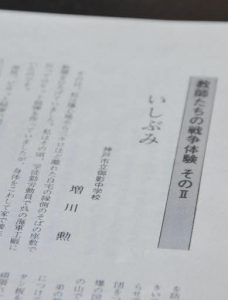Striving to fill voids in Hiroshima—Unknown last moments of first-year Second Middle School student who died with entire class in A-bombing during work mobilization described in older brother’s personal account
Apr. 22, 2021
Account donated by older brother’s former coworker to Hiroshima National Peace Memorial Hall for Atomic Bomb Victims
by Junji Akechi, Staff Writer
Isao Masukawa, the older brother of Tadashi Masukawa, who died of the atomic bombing when he was a first-year student at Hiroshima Second Middle School (present-day Kanon High School), left behind a personal account describing his younger brother’s last moments. Tadashi was one of the students whose detailed circumstances at death were not identified in the series of articles “Record of Hiroshima: Photographs of the Dead Speak” published by the Chugoku Shinbun in 1999 to precisely track the circumstances at the time of death of students from the Second Middle School at the time of the atomic bombing. Naoto Kirifuji, 74, a former colleague of the older brother who lives in Nishinomiya City in Hyogo Prefecture, donated Isao’s personal account to the Hiroshima National Peace Memorial Hall for the Atomic Bomb Victims, located in the city’s Naka Ward, earlier this year in March, in hopes that the account would be preserved as a record.
The personal account was contained in a collection of manuscripts used for peace education compiled by the Hyogo Prefectural Education Center in 1983. In the essay titled “Ishibumi” (in English, ‘Stone monument’), Isao, who worked as a math teacher at a municipal junior high school in Kobe City, briefly describes his experience.
According to the account, Isao, 19 at the time and a second-year student at the former Hiroshima High School (present-day Hiroshima University), experienced the atomic bombing at his home in the area of Ushita-cho (now part of Hiroshima’s Higashi Ward) on August 6, 1945. He was at home because he had taken the day off from work at the Kure Naval Arsenal, where he had been mobilized, due to illness. Tadashi had been mobilized for the work of dismantling buildings to create fire lanes in what used to be known as the Nakajima-shinmachi district (now part of Naka Ward) on the left bank of the Honkawa River. He did not return home that day.
The following day, August 7, based on information about Tadashi’s whereabouts, Isao found his brother on the West Drill Ground (in Hiroshima’s present-day Naka Ward) with severe burns on his face and limbs. Isao’s account indicated that, “When I said, ‘Hey, I’m here. Don’t give up,’ my brother replied, ‘I will never die, never die.’” Tadashi soon passed away, however, and Isao brought his brother’s body back home. Isao placed Tadashi’s body in a box designed for a Japanese koto and cremated it. His mother, who experienced the atomic bombing near their home, died four years later. Isao wrote that, in 1947, he started work as a teacher in Onomichi City, Hiroshima Prefecture.
Isao seems to then have moved to Kobe City. In 1982, Mr. Kirifuji asked him to recount his experience on the day of the atomic bombing to students at the junior high school where both were working. Mr. Kirifuji made the request because he had learned that his colleague Isao, who was more than 20 years his senior, was an A-bomb survivor. Mr. Kirifuji was born after the war ended but his interest in peace education as a social studies teacher was strong.
On a school day scheduled during the summer holiday, more than 300 of their third-year students listened to Mr. Masukawa’s story about his A-bombing experience in absolute silence. He remembered Isao had shown hesitation for a time after standing in front of the students. He then began to speak about what had happened to him “37 years ago.” Later, he accepted Mr. Kirifuji’s request to write his personal account about that experience.
All of the first-year students at Hiroshima Second Middle School, including Tadashi, who were on site for building demolition work died in the atomic bombing. A memorial monument is inscribed with the names of the 323 students, including those who were identified later. The series “Record of Hiroshima: Photographs of the Dead Speak” revealed the final moments of 282 students who had been identified as of 2000, but both Tadashi’s bereaved family and the circumstances of his death were unknown at that time the series was published. The school’s alumni association had also not been able to get hold of any contact information for the family.
Eiji Nakano, 88, a resident of Higashihiroshima City who was in the same class as Tadashi, responded in an interview over the telephone while in the hospital. “Tadashi was one of the two classmates known to be smart. Although many classmates’ whereabouts remain unknown, I’m grateful to have the chance to learn of his last moments in this way,” said Mr. Nakano.
Inspired by the entry into force of the Treaty on the Prohibition of Nuclear Weapons (TPNW) in January this year, Mr. Kirifuji looked into the contents of Isao’s personal account. Based on the Chugoku Shinbun articles from the past, he found that Tadashi’s last moments were unclear. He tried to reach out to Isao Masukawa listed in a directory of school personnel, but could not locate him. With that, he donated the personal account to the National Peace Memorial Hall. Mr. Kirifuji said, “I just wanted to leave a record that fills in some of the voids of history. I only spent several years with him as colleague at the same school, but the donation is to repay him for telling us about his painful memories.”
(Originally published on April 22, 2021)








